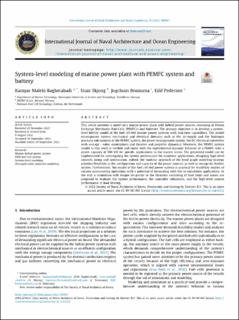| dc.contributor.author | Malekibagherabadi, Kamyar | |
| dc.contributor.author | Skjong, Stian | |
| dc.contributor.author | Bruinsma, Jogchum | |
| dc.contributor.author | Pedersen, Eilif | |
| dc.date.accessioned | 2023-01-12T10:24:52Z | |
| dc.date.available | 2023-01-12T10:24:52Z | |
| dc.date.created | 2022-10-11T14:58:38Z | |
| dc.date.issued | 2022 | |
| dc.identifier.citation | International Journal of Naval Architecture and Ocean Engineering. 2022, 14 . | en_US |
| dc.identifier.issn | 2092-6782 | |
| dc.identifier.uri | https://hdl.handle.net/11250/3042960 | |
| dc.description.abstract | This article presents a model of a marine power plant with hybrid power sources consisting of Proton Exchange Membrane Fuel Cells (PEMFCs) and batteries. The primary objective is to develop a system-level fidelity model of the fuel cell-fed marine power systems with real-time capabilities. The model encompasses various mechanical and electrical domains such as the air-supply and the hydrogen auxiliary sub-systems of the PEMFC system, the power management system, the DC electrical converters with average - value assumptions and thruster and propeller dynamics. Moreover, the PEMFC system model in this work is verified and tuned with the experimental dynamic behavior of a PEMFC with a power capacity of 500 kW for specific applications in the marine sector. The presented model can be implemented for investigating the system performance for simulator applications, designing high-level controls, sizing and optimization. Indeed, the modular approach of the bond graph modeling strategy provides flexibility in the configuration and capacity of the power sources, as well as storage for further studies. Furthermore, this model of the fuel cell-fed power system is practical for feasibility studies of various maneuvering operations with a potential of integrating with the co-simulation applications. In the end, a simulation with torque set-points to the thrusters consisting of load steps and noises are proposed to evaluate the system performance, the controller robustness, and the high-level control performance in load sharing. | en_US |
| dc.language.iso | eng | en_US |
| dc.publisher | Elsevier | en_US |
| dc.rights | Attribution-NonCommercial-NoDerivatives 4.0 Internasjonal | * |
| dc.rights.uri | http://creativecommons.org/licenses/by-nc-nd/4.0/deed.no | * |
| dc.subject | Averaged-value converter modeling | en_US |
| dc.subject | System-level modeling | en_US |
| dc.subject | Cell system | en_US |
| dc.subject | PEM fuel | en_US |
| dc.subject | Marine hybrid power system | en_US |
| dc.title | System-level modeling of marine power plant with PEMFC system and battery | en_US |
| dc.title.alternative | System-level modeling of marine power plant with PEMFC system and battery | en_US |
| dc.type | Peer reviewed | en_US |
| dc.type | Journal article | en_US |
| dc.description.version | publishedVersion | en_US |
| dc.rights.holder | © 2022 Society of Naval Architects of Korea. Production and hosting by Elsevier B.V. This is an open access article under the CC BY-NC-ND licens. | en_US |
| dc.source.pagenumber | 13 | en_US |
| dc.source.volume | 14 | en_US |
| dc.source.journal | International Journal of Naval Architecture and Ocean Engineering | en_US |
| dc.identifier.doi | 10.1016/j.ijnaoe.2022.100487 | |
| dc.identifier.cristin | 2060557 | |
| dc.relation.project | Norges forskningsråd: 237917 | en_US |
| cristin.ispublished | true | |
| cristin.fulltext | original | |
| cristin.qualitycode | 1 | |

